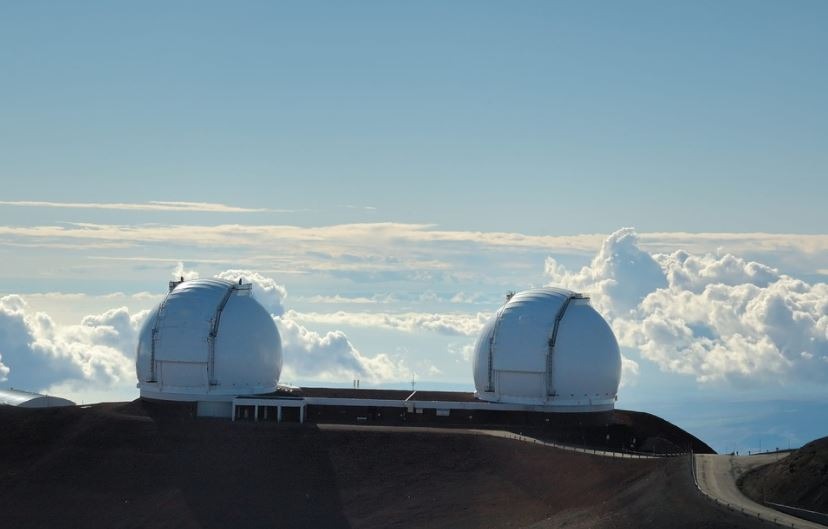Hawaii is home to some of the major telescopes and observatories around the world as it’s the Earth’s point of connection to the rest of the universe. In the state of Hawaii, there are currently 27 astronomical observatories with professional telescopes for astronomy studies. Although some observatories are compounds with many telescopes on the same site, not all observatories are available to the public.
Continue reading to learn more about Hawaii’s most important observatories and telescopes.
Mauna Kea Observatories (MKO)
Mauna Kea or White Mountain, a dormant volcano on the Hawaiian islands, is Hawaii’s most extensive and southernmost island. It’s roughly 300 kilometers (190 miles) away from Honolulu, on the island of Oahu. Mauna Kea, the tallest peak in the Pacific Basin and the world’s highest island mountain, rises 9,750 meters (32,000 feet) from the ocean floor to 4,205 meters (13,796 feet) above sea level, putting its summit beyond 40% of the Earth’s atmosphere.
The summit area’s vast volcanic scenery is composed of cinder cones atop a lava plateau. Mauna Kea’s lower slopes are famous for hunting, trekking, tourism, and bird viewing in a less sterile environment than the barren summit area.
The largest global astronomical observatory, featuring telescopes manned by astronomers from 11 countries, is located on the top of Mauna Kea. The telescopes on the mountain have a total light-gathering power that is fifteen times greater than the Palomar telescope in California, which was the world’s most enormous and 60 times greater than the Hubble Space Telescope for several years.
There are now thirteen operational telescopes near Mauna Kea’s summit. Nine are dedicated to infrared and optical astronomy, three to submillimeter wavelength astronomy, and one to radio astronomy.
The UKIRT, the world’s largest dedicated infrared telescope; the JCMT, the world’s largest submillimeter telescope; and the most excellent optical/infrared telescopes (the Keck telescopes) are among them. The Very Long Baseline Array’s (VLBA) westernmost antenna is located two miles from the peak at a lower altitude.
Mauna Kea is a one-of-a-kind astronomical observatory. The atmosphere well above the mountain is cloud-free and highly dry, which is critical for monitoring submillimeter and infrared radiation from celestial sources, resulting in one of the world’s most extraordinary proportions of clear nights.
Mauna Loa Baseline Observatory (MLO)
The Mauna Loa Observatory (MLO) is situated on the north flank of the Mauna Loa Volcano on Hawaii’s Big Island, at the height of 3397 meters (11,135 ft) above sea level. Since the 1950s, the observatory has regularly monitored and gathered data linked to atmospheric change as a renowned atmospheric research institution.
The observatory protrudes over the region’s significant marine temperature inversion layer, which divides the region’s much cleaner free troposphere from the more polluted lower atmosphere. MLO’s distant location, cool air, and low human activity and vegetation influences make it suitable for monitoring atmospheric elements that can cause climate change.
Hundreds of collaborative research activities with domestic and international government entities and universities have been supported by MLO. The observatory is run and maintained by an eight-person staff based in Hilo, Hawaii.
W. M. Keck Observatory
Astronomers worldwide utilize the W. M. Keck Observatory on Maunakea, Hawaii, to explore the universe with unparalleled power and precision.
The twin Keck Observatory telescopes, the world’s most giant and scientifically productive optical and infrared telescopes, are housed at the W. M. Keck Observatory. Every telescope weighs 300 tons and has a nanometer-level of accuracy. The telescopes’ primary mirrors are 10-meters in diameter and made up of 36 hexagonal segments that function together as a single sheet of reflective glass.
Keck Observatory is a 501(c)3 organization that receives money from private and public sources. The Keck telescopes have a set of adaptive optics capabilities and state-of-the-art observation instruments to acquire and interpret astronomical data.
NASA, Caltech, the University of Hawaii, the University of California, NOIRLab, and Notre Dame University can use the Keck Observatory 10-meter telescopes for observation. Caltech provides telescope time to Yale University, Northwestern University, and the Swinburne University of Technology. Through an observatory exchange, the Subaru Telescope community has access to Keck Observatory.
Canada-France-Hawaii Telescope (CFHT)
A world-class 3.6 meter infrared/optical telescope is housed at the CFH observatory. The observatory is situated on Mauna Kea’s summit. This dormant volcano rises to 4200 meters above sea level on the Hawaiian island of Oahu and is home to the 12 Mauna Kea Observatories.
In 1979, the CFH Telescope went operational. The purpose of CFHT is to provide a state-of-the-art and versatile astronomical observing facility for its user community that is well matched to their research goals and fully exploits the Mauna Kea site’s capabilities.
CFHT has been a part of the Waimea community since 1977, and the Observatory headquarters are located there. Waimea is a small country town of 13,000 people located 2,500 feet in the trough between the Kohala mountains and the dormant volcano Mauna Kea. It was tagged one of the ten most attractive locations to live in the U.S. by the Robb Report in 2000 and has maintained its 150-year-old Paniolo (cowboy) culture while also providing numerous modern conveniences.
Waimea is home to excellent schools, the Kahilu Theater, a modern hospital, retail centers, more than a dozen restaurants, and more, in addition to its verdant fields grazed by horses, cows, goats, and sheep.
